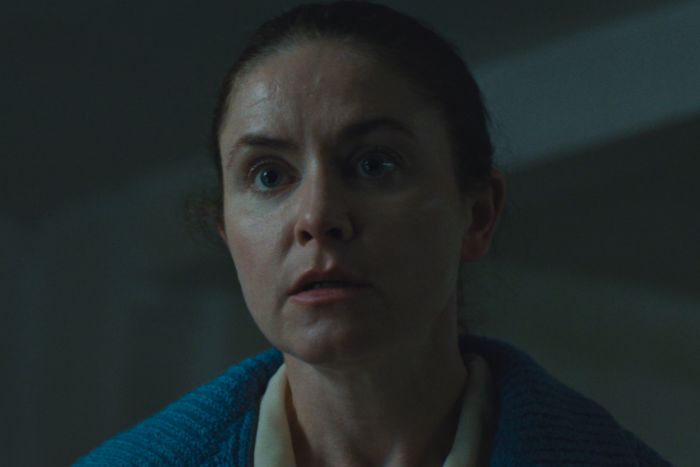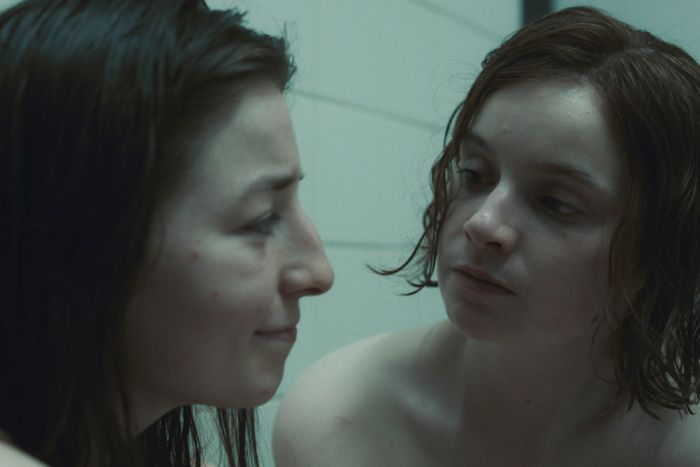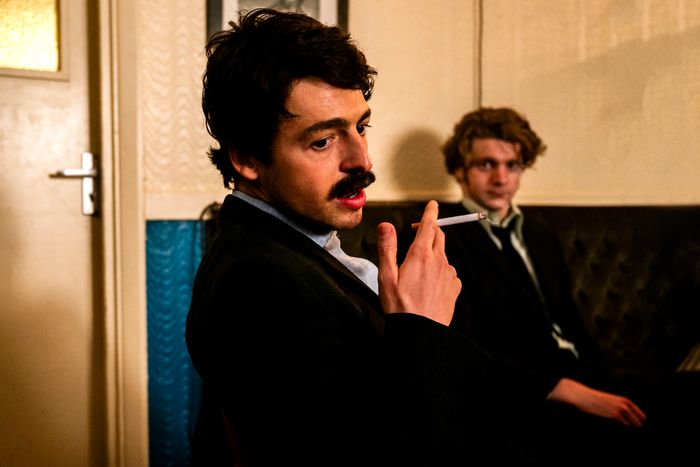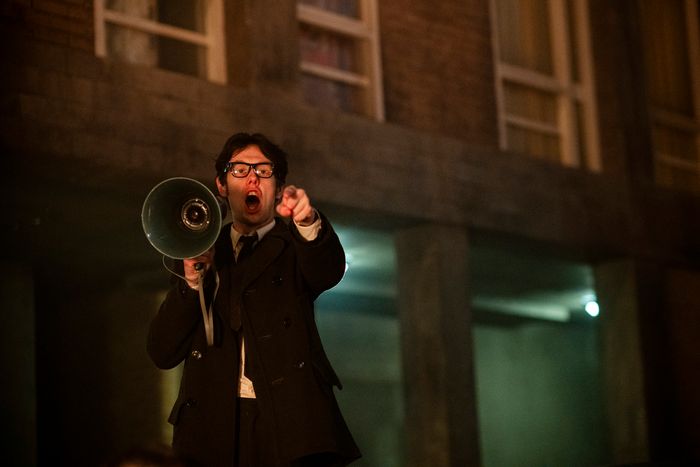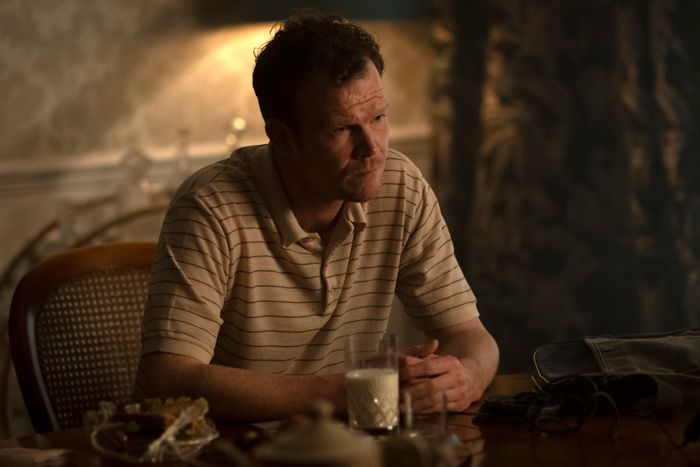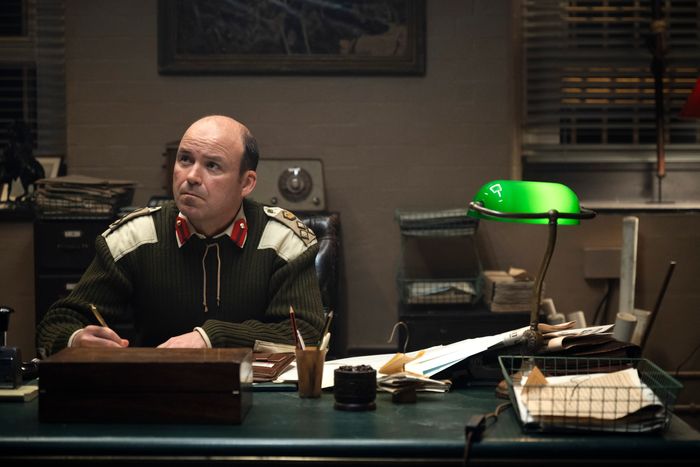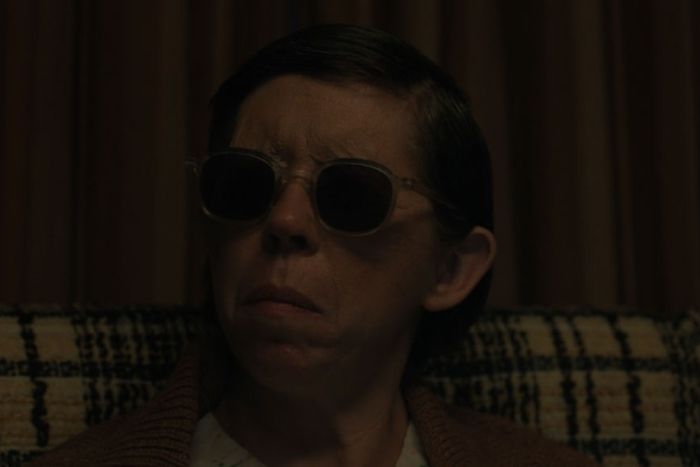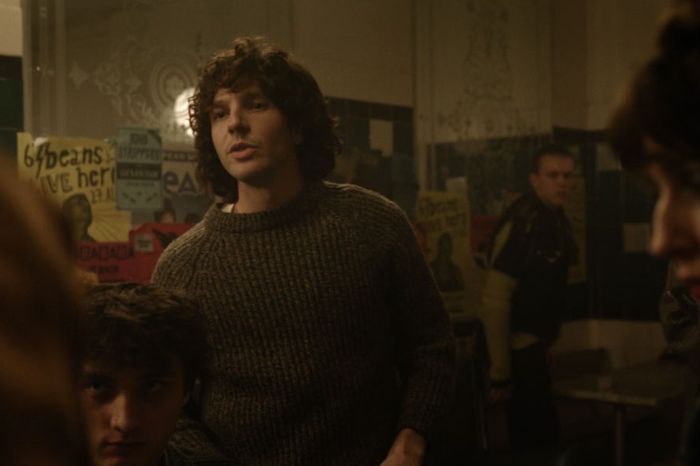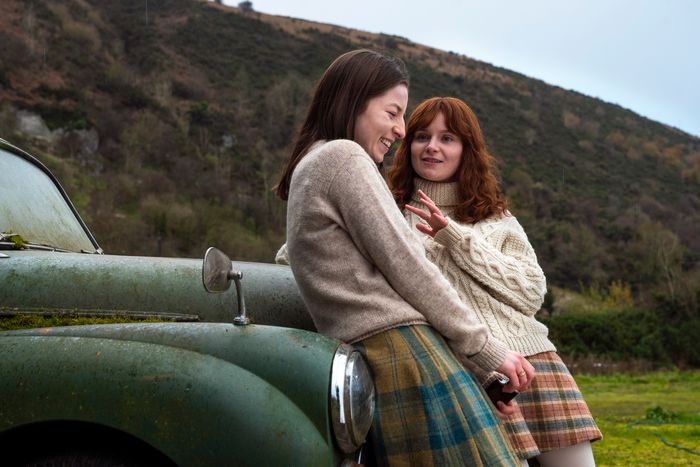
The trailer for Say Nothing emphasizes the capers and heists that mark the series’ first episodes, but FX’s new adaptation of Patrick Radden Keefe’s spellbinding 2018 book is fundamentally a tragic story illuminated by glimmers of hope. A widowed mother of ten is abducted from her home by her neighbors, in front of her children, never to be seen again. Two sisters who vow to give their lives for the promise of a united Ireland nearly die while on hunger strike in prison for having car-bombed London’s Old Bailey and Ministry of Agriculture. A revolutionary leader builds a successful political career and legacy as a peacemaker while his closest friends and allies grieve and rage against his denial of their shared history. Everyone struggles to make meaning of the violence they either perpetrated, suffered, or both during The Troubles, the peculiarly benign name given to the nearly 30-year period of intense sectarian violence between unionist (mostly Protestant) and republican (mostly Catholic) paramilitaries over the political and social fate of the six counties that make up Northern Ireland (or the North of Ireland, depending on your view of history and political bent).
After most of what is now the Republic of Ireland won its independence from Great Britain in 1920, Britain’s formal retention of Northern Ireland in 1922 established a dramatically two-tiered state, where Protestants enjoyed far more political, economic, and social power than Catholics. In the 1960s, Catholic activists launched a civil rights campaign drawing in part on the philosophy and peaceful direct action of the Civil Rights Movement for Black liberation in the United States. When the effort failed in 1969, British troops arrived to keep the peace, but ultimately ushered in the mounting violence and upheaval of The Troubles, leading to a 30-year military occupation and unyielding, seemingly insurmountable entrenchment by both unionists and loyalists. Following the 1999 enactment of the Good Friday Agreement, many of the paramilitaries newly freed from prison were left at loose ends while much of their recollections of and perspectives on the conflict were still locked away behind omertà-style oaths of secrecy.
There’s a purposeful and potent disconnect between the command of the series’ title — drawn from Seamus Heaney’s 1975 poem “Whatever You Say, Say Nothing” — and its characters’ need to talk about both what they’ve experienced and what they’ve done to others. Brendan Hughes and Dolours Price needed it so badly that they spoke about their lives and actions at length, in secrecy and under the threat of death. We’re taking a closer look at how those lives and actions as depicted in Say Nothing align with the historical record as reported by Keefe and others, to pinpoint when and how the series veers into fiction.
(Note: Due to Say Nothing’s depiction of historical events, this article includes spoilers.)
Jean McConville (played by Judith Roddy)
Jean McConville was a widowed mother of ten living in the high-rise warren of Divis Flats, a massive public housing complex in West Belfast. Her abduction from her home in late 1972 is the opening scene of Say Nothing, and the mystery surrounding her disappearance and execution, as well as the long-unknown location of her body, is the thread connecting all of the series’ narrative strands. The abduction is depicted as a raid on her flat led by a group of her neighbors, some masked, some not. In the series’ eighth and ninth episodes, several of her now-grown children name the experience of seeing her abductors around town, living their lives seemingly unburdened by guilt over their actions, as worsening their decades-long anguish.
In its portrayal of McConville, Say Nothing hews especially close to the facts Keefe presents in both his book and 2015 New Yorker piece “Where The Bodies are Buried.” Her time on-screen is minimal, but vital to setting up the relief of her body being recovered in 2003, as well as the ninth-episode showdown between PSNI detectives and widely alleged IRA leader Gerry Adams 11 years later, when he flatly denies any involvement in her abduction and murder.
Brendan Hughes and Dolours Price later fill in some of the blanks in their interviews with Anthony “Mackers” McIntyre, who is conducting an oral history project about The Troubles housed at Boston College. They accuse McConville of having been a tout and state flatly that Gerry Adams ordered her to be taken across the border to the Republic of Ireland to be executed and buried. The series itself seems skeptical of the idea that McConville was a tout, however, suggesting visually if not verbally that the real reason for McConville’s abduction and murder is that she drew the resentment and disapproval of her neighbors for refusing to hide guns used in IRA missions, and later, for giving a blanket to an injured British soldier. Regardless of the specific charges against her, Jean McConville was the victim of a war crime, disappeared by the IRA to spare them the public shame of dumping the corpse of a young widow and mother on the street.
Dolours Price (Young Dolours played by Lola Petticrew; Older Dolours played by Maxine Peake) Marian Price (Young Marian played by Hazel Doupe; Older Marian played by Helen Behan)
As the daughters of steadfastly republican parents in Catholic-dominated West Belfast, Dolours and Marian Price were ideal IRA recruits, but with a twist: they weren’t interested in the support roles offered by the women’s wing of the organization. No “rolling bandages and serving tea” for Albert and Chrissie’s girls — the Price sisters wanted to be combatants. The sisters’ gender and good looks were immediate assets, subverting the British Army’s expectations of what a paramilitary would look like and allowing them get away with activities that would draw suspicion and negative attention when done by men, like walking around town with guns in their purses and transporting explosive materials from the Republic of Ireland back to Belfast .
Say Nothing hews quite closely to the historical record in its presentation of Dolours and Marian, but either fine-tunes or creates several events for dramatic purposes. The 1973 mission to plant four car bombs at significant sites in London emerges in episode five as the fully formed brainchild of Dolours and Marian. As Keefe relates, however, while the idea was “at least in part Dolours Price’s,” the process of fleshing out the idea into a plan was iterative, starting as a mission to firebomb London, which failed due to flaws in the bombs’ construction. Members of the Belfast Brigade assisted in the refinement of the eventual car-bombing mission.
The series’ sixth and best episode focuses exclusively on the Price sisters’ imprisonment at HMP Brixton and the hunger strike they maintained for 206 days in a harrowing, ultimately successful effort to shame the British government into granting their request to be moved to a prison in Northern Ireland. They lived so long while fasting because they were force-fed daily throughout much of the strike, a gruesome and inhumane practice that was eventually stopped when the sisters’ physical resistance made safe placement of the feeding tubes impossible. Along the way, Dolours befriends the kindly Dr. Mansuri, whose approach to force-feeding is as harm-reducing as possible under the circumstances. Dr. Mansuri is a creation of the show, but in reality, Dolours and Marian did have a warm relationship with an older prison doctor named Ian Blyth.
In the series’ final episode, Dolours is outraged by Gerry Adams’s presence at Brendan Hughes’s funeral and his quiet insistence on taking a spot as one of the pallbearers marching his bitterly estranged friend’s casket to the cemetery. Her comments are so loud that Mackers drags her away from the funeral procession, where she really unloads, yelling “This is a hijacking! Brendan Hughes wanted that man dead!” In Keefe’s telling, Dolours was critical of Adams inserting himself as a pallbearer, but “felt something unexpected: a pang of sympathy” for her former friend, who now “looked so uneasy” and “lonely.”
Prior to her January 2013 death from an apparent accidental overdose of prescription medications, Dolours Price acknowledged in an interview with Mackers that she had driven Jean McConville across the border to her death. Marian Price was incarcerated at the time of her sister’s death, but was given a several-hour furlough to attend Dolours’s wake, and was released from prison later that year. Marian, who is strongly implicated in both the book and the limited series as Jean McConville’s murderer, is still alive, and denies any involvement in McConville’s death.
Brendan Hughes (Young Hughes played by Anthony Boyle; Older Hughes played by Tom Vaughan-Lawlor)
Hughes, often called The Dark thanks to the color of his hair, eyes, and mustache, was the leader of D Company in the Provisional IRA’s Belfast Brigade. Say Nothing depicts him as a cheeky charmer, the kind of leader every soldier wanted to follow, thanks to his combination of charisma and principled bravery. Unlike his close friend Gerry Adams, whose mind for strategy and drive toward self-preservation kept him shuttling among various safe houses, Hughes was most at home in the streets.
It was a high-risk, high-stakes way to live, but Hughes enjoyed a safeguard almost unimaginable today: the British Army didn’t know what he looked like. His father had destroyed all photos of his son, and since Hughes had never been arrested, he didn’t have a criminal record. The second episode illustrates the scope of the resources and intelligence operation required to identify and attempt to hunt him down. British intelligence expert Frank Kitson deployed several field agents in an ice cream van roaming the streets of West Belfast to surreptitiously film people out and about in the neighborhood, then softened up one of Brendan’s men to the point that he identified everyone in D Company, allowing the Army to find and attempt to capture Hughes. The scene grows into a dazzling set piece shot partially from above as Hughes, who knows every inch of the neighborhood, dashes across streets, through backyards and houses to reach a local call house where he’s got an Armalite and ammunition stashed. He nearly bleeds to death after cutting his radial artery in the escape, saved once Gerry arrives with a veterinarian friendly to the cause to patch him up.
Keefe’s “Where The Bodies Are Buried” corroborates most of this, with only the ice cream van and the veterinarian standing out as adjusted narrative details; Keefe’s book elaborates further that they were a green van and “a local heart surgeon,” respectively.
Gerry Adams (Young Adams played by Josh Finan; Older Adams played by Michael Colgan)
Gerry Adams is probably the person most widely known to U.S. viewers of Say Nothing, having started his public life in the late 1960s as a dedicated civil rights activist and largely concluded it in 2018 as a respectable elder statesman who led the once-IRA-affiliated republican political party Sinn Féin for 35 years, and an icon of the peace process that led to the 1998 ratification of the Good Friday Agreement. Despite that prominence — or maybe because of it — comparing fact and fiction is particularly challenging in Adams’ case, requiring almost a reversal of this entire exercise: While the series consistently depicts his involvement in and leadership of the IRA’s Belfast Brigade, he says that he never participated in any of it. Thus, each of Say Nothing’s nine episodes concludes with a disclaimer: “Gerry Adams has always denied being a member of the IRA or participating in any IRA-related violence.”
The cumulative effect of the repeated disclaimer is an hour-by-hour ratcheting up of grim absurdity. How can Adams deny having been the IRA leader described in such detail by Dolours Price and Brendan Hughes? Theirs are not the only claims: Keefe’s book also covers Adams’ internment at Long Kesh (later HMP Maze) from 1973 to 1977, his close friendship with cellmate Hughes, and pseudonymous authorship of a long-running column in An Phoblacht, the IRA newspaper of which Sinn Féin later assumed publication. In a 2018 interview with the BBC, Adams threaded the needle by saying he was always a republican activist, and that he didn’t distance himself from the IRA, but saw no reason to join because he was already active in Sinn Féin and knew that “the whole trajectory within republicanism was to build politically” in pursuit of a negotiated settlement. Keefe’s book carefully addresses Adams’ gradual conviction that the armed struggle and political change would be equally significant aspects of the quest for a peaceful and reunited Ireland, while noting that his “refusal to acknowledge that he was ever in the IRA” contributed to “a queasy sense of irresolution” even after the passage of the Good Friday Agreement.
The release of interviews with Price and Hughes provided the PSNI with enough evidence to arrest and interrogate Adams about the disappearances of Jean McConville, Joe Lynskey, Seamus Wright, and Kevin McKee. The final episode dramatizes that 2014 arrest and questioning in a remarkable scene that both gives Adams room to explain himself and forces him to explain himself, but Say Nothing never indulges in so much as a winking moment of breaking the fourth wall to say “can you believe this guy?” It doesn’t have to. The disclaimers speak for themselves.
Anthony “Mackers” McIntyre (played by Seamus O’Hara)
We meet Anthony “Mackers” McIntyre in the first episode of Say Nothing, reassuring Dolours Price as he sets up his recording equipment in her Dublin home that their conversation, recorded as a contribution to Boston College’s oral history Belfast Project, will be held in confidence until her eventual death. In his interviews with both Dolours and Brendan throughout the series, Mackers is something like a secular priest, asking probing questions and letting his subjects unburden themselves.
Mackers, as presented in Say Nothing, is less fictionalized than whittled down. For example, the easy rapport between him and his interview subjects is real, because he was a former IRA volunteer himself, and was close friends with Hughes, with whom he’d served time before becoming an historian post-incarceration. The Belfast Project organizers hired Mackers to conduct interviews with republicans because he “was at ease with retired revolutionaries, which suggested that they might open up to him, on tape, about secrets they had kept for decades.”
Frank Kitson (played by Rory Kinnear)
British Army Counterintelligence expert Brigadier Frank Kitson quite literally swoops into Belfast in a helicopter, accompanied by his precocious daughter Penelope, in the second episode of Say Nothing. His arrival and leadership mark a serious turn for the worse for local IRA operatives, as he brings to bear considerable expertise in insurgency-foiling thanks to his service during Kenya’s Mau Mau Rebellion in the 1950s. By coaching his men (and one woman) in using enticements, threats, and violence to flip lower-level, lower-commitment IRA volunteers, Kitson visually identifies not just his highest-priority targets, Brendan Hughes and Gerry Adams, but all of the men of D Company. The last substantive moment we have with Kitson comes when he shrugs off the likely deaths of two of his highest-value IRA double-agents, Seamus Wright and Kevin McKee, at the end of episode four.
If anything, Say Nothing understates the impact of Kitson’s 1970-72 tenure in Belfast and well beyond, during which he, in the words of one Northern Irish politician, “probably did more than any other individual to sour relations between the Catholic community and the security forces.” The series depicts his arrival in the midst of an intense period of open conflict between republicans and the Army. But the historical record suggests that the adoption of his counterinsurgent techniques (which, despite their ironic categorization as “low-intensity operations”, included assassinations of IRA operatives by an elite squad) and dramatic increase in deployed troops actually poured accelerant on the banked coals of a fragile détente between the occupiers and occupied.
Bridie Dolan (played by Eileen Walsh)
Dolours and Marian Price grew up attending to the needs of their maternal aunt Bridie Dolan, who needed assistance with everything from bathing and eating to chain-smoking. As a young woman, Bridie had been an IRA bomb maker, and had lost both her vision and her hands in an explosion. Consequently, her nieces revere her as an icon of republican self-sacrifice.
There’s only the tiniest shaft of daylight between the way Auntie Bridie appears on-screen in Say Nothing and Keefe’s description of her in his 2015 New Yorker piece: “She had been horribly disfigured at twenty-seven, after accidentally dropping a cache of gelignite in an Irish Republican Army explosives dump. The blast blew off both of her hands, and permanently blinded her.” The fictional Aunt Bridie serendipitously gives Dolours and Marian the idea to bomb London at the end of episode four, when she suggests that “maybe someone ought to remind” the English that they’re in a war with Northern Ireland. It’s a small narrative flourish, and in the absence of evidence to support it having happened, likely a fictional one.
Stephen Rea (played by Damien Molony)
Stephen Rea is Say Nothing’s second-most-likely person to be known to American viewers. The Belfast native is most famous here for his Academy Award-nominated performance as an IRA gunman in The Crying Game, but appears at length only in episode seven, as a stage actor. As seen in episode five, Dolours is very moved by his performance in The Freedom of The City, the Brian Friel play she attends the night before the London bombing mission in 1973. Their paths cross again as a newly free Dolours gets chatty with him at the bar in Belfast’s Lyric Theatre. Each of them is starstruck by the other, and they quickly fall in love. By the end of the eighth episode, they’ve divorced after having two sons together and Dolours is deep in the grip of alcohol and prescription drug dependency.
It’s unclear precisely where and how the real Rea and Price renewed their acquaintance after her release from prison, but they married in 1983 and divorced in 2003; he was a pallbearer at her funeral in 2013. One detail the miniseries elides is one for the You Can’t Make This Up books: From 1988-1994, the British government instituted a ban on broadcasting the voices of leaders among terror-supporting organizations in Northern Ireland. Theoretically, the broadcast ban was aimed at both loyalist and republican groups, but the primary target was Sinn Féin and, consequently, Gerry Adams. In order to report accurately on statements made by Adams, the BBC devised the work-around of hiring actors from Northern Ireland to perform his words. In 1990, one of the actors who recorded voiceover work in Adams’ voice was Stephen Rea.
More ‘Say Nothing’
- The 10 Best TV Needle Drops of 2024
- Say Nothing Says Too Much
- ‘Your Nose Is Pressed Up Against the Ambiguity of It’


